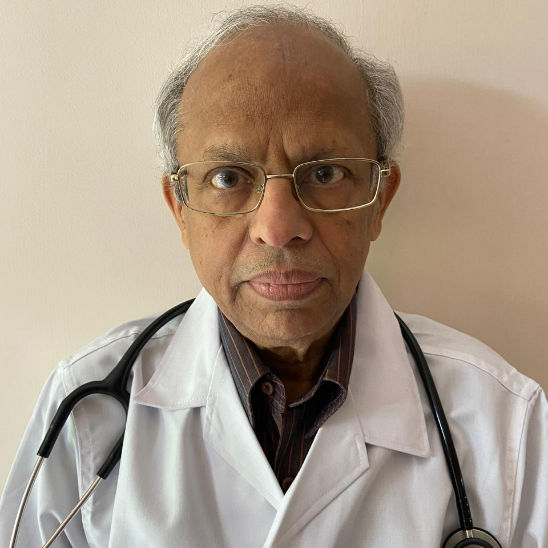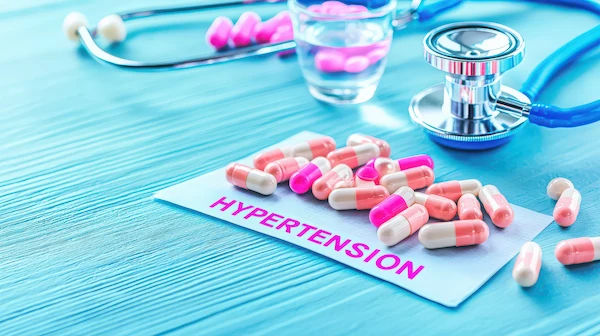Blood Pressure and Stroke
Learn about the causes and treatment of blood pressure and stroke. Gain insights into how to improve blood pressure, reduce stroke risk, and treatment to look after yourself.

Written by Dr Sonia Bhatt
Last updated on 3rd Jul, 2025
Did you know managing your blood pressure could be the key to preventing a stroke? High blood pressure is often called the silent killer as it increases your risk of life-changing conditions without any obvious signs.
In this article, we’ll explore the link between blood pressure and stroke, and break down how high blood pressure affects your brain. You’ll also find practical steps to manage your blood pressure, recognise the warning signs and reduce your stroke risk.
Understanding Blood Pressure
Blood pressure is a key health indicator of the blood's force against the artery walls. It’s measured as two numbers:
Systolic Pressure: The top number is when the heart beats and pumps blood into the arteries.
Diastolic Pressure: The bottom number indicates the pressure when the heart rests between beats and blood flows into the heart.
Normal vs. High Blood Pressure
Here are the key differences between normal and high blood pressure.
| Aspect | Normal Blood Pressure | High Blood Pressure |
| Reading | ≤120/80 mmHg | ≤130/80 mmHg |
| Risk Factors | Low | Increases risk of stroke, heart attack, and kidney disease |
| Symptoms | None | Mostly asymptomatic; can include headaches, dizziness, or nosebleeds |
Over time, high blood pressure damages the arteries and can lead to serious health issues like heart disease and stroke. Several factors contribute to hypertension, like a high salt diet, lack of exercise, excessive alcohol consumption, chronic stress, and genetics.
Understanding Stroke
A stroke happens when blood flow to a part of the brain is interrupted, and the brain is starved of oxygen and nutrients needed for normal functioning. If left untreated, brain cells start to die, which can lead to disabilities or even death.
There are three types of stroke:
Ischaemic Stroke: This is the most common type and is caused by blockages or narrowing of the brain arteries.
Haemorrhagic Stroke: This occurs when a blood vessel in the brain bursts and bleeds (haemorrhage).
Transient Ischaemic Attack (TIA): Also known as a mini-stroke, TIA is a temporary disruption of blood flow to the brain.
Common Causes of Stroke
Here's how different factors lead to a stroke:
High Blood Pressure: It damages blood vessels and increases the risk of clots or rupture.
Atherosclerosis: Plaque buildup narrows arteries, which reduces blood flow to the brain.
Heart Disease: Irregular heartbeats and heart failure can send clots to the brain.
Diabetes: High blood sugar weakens blood vessels, which can increase stroke susceptibility.
Smoking: Chemicals in cigarettes promote clot formation and damage blood vessels.
Obesity: Excess weight strains the cardiovascular system.
High Cholesterol: LDL (low-density lipoprotein) cholesterol causes artery blockages.
Alcohol Abuse: Heavy drinking spikes blood pressure and weakens arteries.
Drug Use: Substances like cocaine can trigger blood vessel spasms or ruptures.
Genetics: Family history or inherited conditions may heighten stroke risks.
Chronic Stress: Raises blood pressure and heightens unhealthy lifestyle habits.
Link Between Blood Pressure and Stroke
Hypertension is the number one cause of stroke. Over time, high blood pressure damages arteries, making them prone to:
Narrowing or hardening
High blood pressure promotes the buildup of fatty deposits (plaque) inside arteries.
These deposits narrow the arteries, restricting blood flow to the brain and increasing the risk of an ischemic stroke.
Aneurysms
The constant strain can weaken artery walls, creating bulging areas known as aneurysms.
If an aneurysm ruptures, it causes bleeding in or around the brain, leading to a hemorrhagic stroke.
Risk Factors for Stroke in Patients With High Blood Pressure
High blood pressure significantly increases the risk of stroke, with several factors compounding this danger. Lifestyle factors like smoking, excessive alcohol intake, unhealthy diets, and inactivity worsen blood pressure, damaging blood vessels over time.
Genetic predispositions also play a role, as a family history of hypertension or stroke increases susceptibility. Additionally, co-existing medical conditions like diabetes, high cholesterol, and obesity further strain the cardiovascular system.
Symptoms of High Blood Pressure
High blood pressure is called the "silent killer" because it has no symptoms, so it’s hard to detect without regular monitoring. But in severe cases, some warning signs may appear:
Severe Headaches: A sudden or intense headache can indicate high blood pressure.
Nosebleeds: Frequent or unexplained nosebleeds may indicate high blood pressure.
Shortness of Breath: Difficulty breathing or feeling winded can happen when blood pressure is very high.
Dizziness: Light-headedness or spinning sensation may also occur in extreme cases.
Symptoms of Stroke
Act F.A.S.T. and save lives. The F.A.S.T. acronym helps you identify the warning signs:
Face: Uneven smile or droop on one side
Arm: Inability to raise one or both arms
Speech: Slurred or garbled speech
Time: Act fast
Additional Symptoms: Sudden confusion, loss of balance, severe headache with no known cause.
Consult Top Neurologist
Diagnosing High Blood Pressure and Stroke Risk
Blood pressure is measured using a sphygmomanometer (blood pressure cuff). Repeated readings above normal indicate the need for intervention.
Doctors use the following tests to assess stroke risk in high blood pressure patients:
Blood Tests: Cholesterol and glucose check.
Imaging: CT or MRI to detect brain damage.
ECG: To check heart health.
Preventative Measures
Taking proactive steps can reduce stroke risk significantly:
Adopting a balanced diet low in salt and rich in fruits, vegetables, and whole grains.
Regular exercise, such as 30 minutes of moderate activity daily.
Avoiding smoking and limiting alcohol intake.
Antihypertensives, such as ACE inhibitors, beta-blockers, calcium channel blockers, and diuretics, are useful for managing high blood pressure. They work by relaxing blood vessels, reducing the heart’s workload, or flushing out excess sodium and fluid from the body.
Monitoring and Check-Ups
Self-monitoring of blood pressure is essential for identifying patterns and detecting changes early. Home blood pressure monitors make it easy to check yourself and take control of your health. Regular follow-ups with your healthcare provider help track progress and deal with medication's side effects.
Treatment Options for Stroke in Hypertensive Patients
Here are some emergency treatments for immediate intervention:
Clot-busting Drugs: tPA (Tissue Plasminogen Activator) for ischemic strokes
Surgical Interventions: to relieve pressure in hemorrhagic strokes
For long-term management, rehabilitation is as essential as medication. This includes:
Physical Therapy: to regain mobility and strength
Speech Therapy: for communication difficulties
Psychological Support: to address emotional and mental well-being
The Importance of Managing Blood Pressure
Managing blood pressure is critical to reducing the risk of stroke and other complications. If left uncontrolled, hypertension can increase the risk of cardiovascular events.
A healthy cardiovascular system indicates that vital organs are doing well in terms of blood pumping. Ensure that you have access to healthcare professionals and go for regular check-ups. Support groups also provide encouragement and shared experiences to make lifestyle changes easier. Combining medical advice with community support is the foundation for good hypertension control and better quality of life.
Conclusion
High blood pressure, or hypertension, is a serious condition that can lead to life-threatening problems like stroke. While it can't always be prevented, there are steps you can take to manage it and lower your risk. The American Heart Association says that at least 3 out of 4 first-time stroke patients show signs of high blood pressure. That’s how important it is to manage hypertension well.
Eating a healthy diet, staying active, avoiding smoking and too much alcohol, and taking your medications as prescribed can make a big difference. Regular check-ups and monitoring your blood pressure early can help prevent complications like stroke or damage to your organs.
With the right care and support from your doctor, you can take control of your health and improve your quality of life.
Consult Top Neurologist
Consult Top Neurologist

Dr. Aditendraditya Singh Bhati
Neurosurgeon
18 Years • MBBS(2004), DNB Neurosurgery(2014); MNAMS; Fellow Neuroendoscopy
Delhi
Apollo Hospitals Indraprastha, Delhi
(100+ Patients)

Dr. Ganeshgouda Majigoudra
Neurologist
10 Years • MBBS, MD ( GENERAL MEDICINE) DM (NEUROLOGY)
Bengaluru
Apollo Clinic, JP nagar, Bengaluru

Dr Rajashekar Mummadi
Neurologist
3 Years • MBBS, DNB General Medicine, DRNB Neurology
Hyderabad
Dr Ram's Neuro Clinic, Hyderabad
Dr. Annakula Ramu
Neurologist
7 Years • MBBS, MD General Medicine, DM Neurology
Jagtial
Sairam Neuro and Children Hospital, Jagtial

Dr. E Prabhakar Sastry
General Physician/ Internal Medicine Specialist
40 Years • MD(Internal Medicine)
Manikonda Jagir
Apollo Clinic, Manikonda, Manikonda Jagir
(125+ Patients)
Consult Top Neurologist

Dr. Aditendraditya Singh Bhati
Neurosurgeon
18 Years • MBBS(2004), DNB Neurosurgery(2014); MNAMS; Fellow Neuroendoscopy
Delhi
Apollo Hospitals Indraprastha, Delhi
(100+ Patients)

Dr. Ganeshgouda Majigoudra
Neurologist
10 Years • MBBS, MD ( GENERAL MEDICINE) DM (NEUROLOGY)
Bengaluru
Apollo Clinic, JP nagar, Bengaluru

Dr Rajashekar Mummadi
Neurologist
3 Years • MBBS, DNB General Medicine, DRNB Neurology
Hyderabad
Dr Ram's Neuro Clinic, Hyderabad
Dr. Annakula Ramu
Neurologist
7 Years • MBBS, MD General Medicine, DM Neurology
Jagtial
Sairam Neuro and Children Hospital, Jagtial

Dr. E Prabhakar Sastry
General Physician/ Internal Medicine Specialist
40 Years • MD(Internal Medicine)
Manikonda Jagir
Apollo Clinic, Manikonda, Manikonda Jagir
(125+ Patients)

